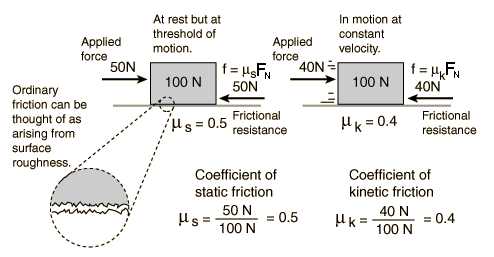Friction is directly proportional to the normal force. Static friction refers to the amount of force required to get something to start moving. Kinetic friction refers to the force that opposes motion while something is moving. The purpose of this lab is to calculate the coefficients of static and kinetic friction between several surfaces. Because the coefficient of friction depends on both surfaces, changing either of the surfaces should change the coefficient. Also, you will determine how surface area and mass affect these coefficients.
 Materials
Materials
You must find the mass of your friction block (in kilograms!) before you begin. Use a spring scale to measure static friction as demonstrated by your teacher. Use a spring scale to measure the kinetic friction also as demonstrated by your teacher. Change the normal force by adding mass in increments of 0.5 kg. Measure the friction forces for at least four different surface combinations using four different masses for each combination of surfaces.
When measuring the friction force remember that performing each experiment three or four times will give you a better idea of the actual force than if you only did each one once.
The force of static friction is the amount of force shown on the spring scale at exactly the moment when the block just starts to move.
The force of kinetic friction is easier to measure. Use Newton’s First Law to justify your determinations.
Devise your own experiment to determine whether surface area of contact has an effect on the force of friction (either static or kinetic).
Hand in your data tables, graphs, sample calculations and the results of the analysis requested above (that is, answer the questions). Do this by hand or on a computer but neatness counts. Show units and show all work for calculations and use a step-by-step approach.
| Surfaces: | |||||||
| Mass (kg) | Normal Force (N) | Static Friction Force (N) | Kinetic Friction Force (N) | μs | μk | Slope μs | Slope μk |
| Avg. | Avg. | ||||||